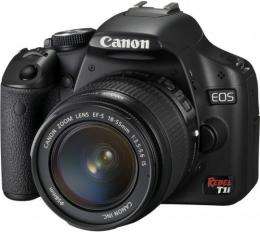New digital cameras offer more for less

An unfortunate jolt to my camera while I boarded a flight to Asia sent me to Best Buy upon my return.
My wounded 4-year-old Canon Digital Rebel -- the lens was damaged when I banged it on the edge of the overhead compartment -- got me to consider buying a new camera.
My trip to the retailer revealed that in the four years since my last major camera purchase, a new generation of shutterbugs has spurred innovation by embracing digital lifestyles. And the volume of sales has pushed gadget prices down.
I paid about $1,000 for my old Digital Rebel. The latest iteration of Canon's digital SLR, the Canon EOS Rebel T1i, aimed at serious amateur shooters, is priced under $800 and comes with high-definition video capabilities.
"Over time, the price of everything goes down. That's how tech works," said Stephen Baker, vice president of industry analysis for NPD Group.
The changes in the designs of digital cameras, particularly those at the low end, reflect the influence of YouTube and Facebook. New social media are shaping digital camera technology. That was on display as I scanned Best Buy's shelves with Jay Parafina, who supervises the camera section at the company's Santana Row store.
Just about every cell phone these days includes a digital camera. But stand-alone cameras -- even at the cheap end -- still generally take higher-quality pictures and offer greater control over elements such as exposure and focus than cell phone cameras.
Digital cameras fall into three general categories: compact point-and-shoots, "high-zoom" and digital SLRs.
As the U.S. market becomes saturated, manufacturers are looking for a sales edge, Parafina said. That includes packing more features into a device for serious photo buffs or giving lower-priced cameras the feel of a fashion item.
"All of them have good picture quality. The difference between them is small. So people want something that will look cool and be fun," Parafina said of lower-end cameras.
Pocket-size digital cameras from the likes of Nikon, Kodak, Fuji and Samsung come in an array of colors, have at least 10 megapixels and usually cost $100 to $200. Others in this category, though, were designed for those looking for something extra.
The Samsung 12.2 Megapixel Dual LCD Digital Camera is one of the higher-priced point-and-shoot models. Retailing at about $250, the device is marketed with the club-frequenting Facebook crowd in mind. The camera has a one-and-a-half-inch LCD screen on the front side for those shooting self-portraits with friends for their Web pages.
Olympus targets extreme sports fans with its Tough-6000 ($280) and Tough-8000 ($380) models -- cameras that are freeze-proof and shockproof for skiers and skateboarders.
"It makes it easy for them to make their own little video and throw it up on YouTube.com," Parafina said. Other manufacturers are producing waterproof cameras for scuba divers and surfers.
Those willing to spend more money might choose a digital single-lens reflex, or SLR, which typically run $500 to $1,000. While prices in this category haven't plunged, manufacturers lure consumers with new and improved features.
"The dynamics of the SLR market are not the same as the point-and-shoot market," Baker said. "These bigger, heavier cameras are for people who are a lot more interested in photography."
In coming years, digital cameras will come with data chips that will enable users to instantly post high-quality photos and videos online, much as they do now with low-resolution pictures taken on mobile phones, said Creative Strategies analyst Ben Bajarin. "These chips will keep you connected to the Internet," he said.
(c) 2010, San Jose Mercury News (San Jose, Calif.).
Distributed by McClatchy-Tribune Information Services.

















